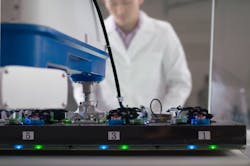Robots have been one of the hottest automation stories of the past few years. From the rise of collaborative robots and expanded integration of vision systems to the simplification of robot programming and control, robotic technologies—and the companies that supply them—are enjoying the benefits of industrial interest in the technology not seen since the automotive industry’s robotic boom of the 1980s.
Despite the considerable advances made in robotic technologies over the past few decades, one area that has remained problematic is material handling. Certainly, there have been significant advances in various end of arm tooling (EOAT) components that can handle a variety of materials with ease. But the goal of meeting or exceeding the dexterity of the human hand still lies beyond the reach of most EOAT technologies.
The difficulties that remain in robotic material handling applications do not, however, mean that significant advances aren’t continuing to be made. In fact, a recent announcement by robotics start-up Grabit shows that work in this area is advancing rapidly and even proving itself capable of outperforming humans.
Rather than attempting to mimic the actions of the human hand, Grabit’s technology uses static electricity—referred to as electroroadhesion—to handle materials. The process uses a flat pad of electrodes to generate positive and negative charges on its surface. When charged correctly, the electrodes create an electric field that adheres to nearly any surface, allowing the robot gripper to pick and place the target material or part.
According to Grabit, until the introduction of electroadhesion, manufacturers have been unable to automate the task of fine materials handling. Grabit’s electroadhesive gripper enables robots to stack such materials, like leathers, meshes and composite fibers.
Grabit’s co-founder and chief technology and products officer, Dr. Harsha Prahlad, discovered the concept of electroroadhesion while working at the non-profit organization SRI International. Prahlad currently holds 36 separate patents related to electroadhesion, with more pending.
Nike is one of Grabit’s investors as well as one of the company’s first customers. Other investors in Grabit include Formation 8, Draper Nexus, Danhua Capital, Samsung, Brother Industries, ABB, Shanghai Electric, Flex, NTT Docomo and the Esquel Group. Nike uses Grabit’s Stackit material handing robot system to produce up to 600 pairs of shoes in an eight-hour shift. Stackit is used by Nike to assemble the layers of material that comprise the shoe’s upper (the top portion of the shoe that covers the foot) 20 times faster than a human.
With the electroadhesion technology developed, Grabit’s next step in the development of Stackit involved finding the right robot on which to mount its electroadhesive gripper.
“Two members of our team already had extensive experience in robot design, and both had been involved in the development of several SCARA robots,” said Greg Miller, president and CEO of Grabit. “This prior understanding of industrial robots enabled us to fine tune our requirements before approaching any manufacturers.”
After selecting a handful of potential robot manufacturers, Grabit planned an extensive test and selection procedure to examine the potential of each one. “The process looked at several factors,” explained Prahlad. “Because of the vast applications for Stackit, we needed a robot with a large reach that would not lose the high levels of precision needed for exacting material handling applications like the shoes from Nike. What’s more, because Grabit’s electroadhesion gripper is so large, the robot needed to be able to withstand a big moment of inertia and offer the ability to rotate accurately.”
Meeting the productivity and capability goals Grabit had set for Stackit proved difficult. Grabit quickly realized that no standard, low-cost robot could meet all of their requirements. Further complicating the issue was the need for Stackit to be a low-cost robot, without exception, as it needed to compete with the low labor rates in countries where footwear and apparel are largely produced.
Grabit’s “unusual” requirements for the Stackit robot complicated the search process even further. Unlike many robotics applications, there was no need for a lot of complex motion and the company did not require the range of movement provided by a standard, six-axis robot. Plus, because Grabit wanted to use its own control system, the company needed access to-low level internal control code and the control package needed to be small enough to fit into a tight space in the design.
This led to a working partnership with Toshiba Machine Robotics. Grabit eventually chose Toshiba Machine’s THL1000 SCARA robot for the Stackit application. This robot is a horizontal multi-joint machine with four controlled axes. With a 1000mm arm length, the allowable moment of inertia for the THL1000 is 0.2kg/m2; and by using absolute encoders, the robots’ repeatability in X-Y is 0.01mm.
The robot offers a maximum payload of 10kg against a total mass of 37kg. With a tested load of 2kg, the machine can achieve a cycle time of 0.48 seconds. However, due to the specific load requirements for Stackit, Grabit’s customized version was created using a different ratio of gears, which enhanced the robot’s payload capability. This improvement, combined with the repeatability of the machine, ensured it was able to deliver the requirements for Grabit’s gripper.
The video below shows Grabit electroadhesion picking and placing metal, fabric, glass and PCB.
Leaders relevant to this article:


